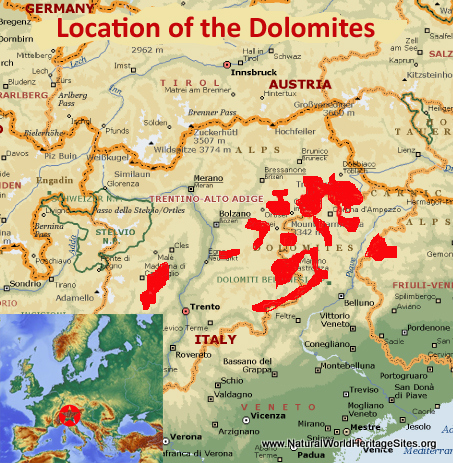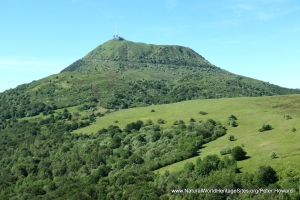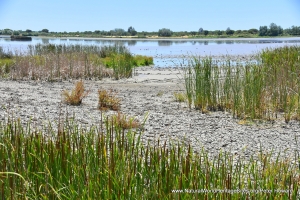EXPLORE the Dolomites with this slideshow, check the location map and get all the facts and information below.
For slideshow description see right or scroll down (mobile). Click to view slideshow
Location and Values: The Dolomites is located in northern Italy, and forms part of the European Alps. It is an extraordinarily beautiful mountain range, with 18 peaks over 3,000m, and an abundance of spectacular rock steeples, pinnacles and cliffs. The outstanding beauty of its landscapes can be attributed to the concentration and diversity of geological features, with pronounced horizontal plateau, ledges and crags contrasting with spectacular vertical features like castles, towers, spires and pinnacles. The geological grandeur of higher elevations is set against the wooded slopes, pastures and valleys below, where picturesque villages and the sound of cow bells enhance the natural setting.
The world heritage site covers nine separate areas at higher elevations, encompassing the more spectacular mountain peaks and associated geological features, within a number of designated protected areas. In terms of its geomorphology and geology, the site is recognized for the quantity and concentration of highly varied and distinctive limestone formations, including Mesozoic carbonate platforms or ‘fossilized atolls’. From a scientific viewpoint, the site includes several important ‘type sections for the stratigraphy of the Triassic period’ where some important fossil discoveries have been made.
Conservation Status and Prospects. According to IUCN’s Conservation Outlook Assessment (2017) the conservation status of the Dolomites world heritage site is ‘good, with some concerns’. The IUCN report notes that an overall management strategy for the various component parts of the site has been agreed between the Foundation Dolomites, UNESCO and local administrations. The main concern is that tourism activities and infrastructure within the site and its surroundings may threaten the site’s values. The IUCN report notes that this tends to be highly concentrated in certain areas, and is being addressed through careful monitoring and intervention where necessary in line with the overall management strategy.
Links:
Google Earth
UNESCO Official Website
IUCN Conservation Outlook
UNEP-WCMC Site Description
Birdlife IBA
Slideshow description
The long series of photos in the slideshow ‘tells the story’ of the Dolomites with a portfolio of photos by Peter Howard from a visit in early June 2019. This is an excellent time to visit the area, when the natural beauty of the place is enhanced by a generous layer of gleaming white snow, yet mountain passes are open, and cable cars are resuming service following the spring ‘maintenance’ break. The photos illustrate the spectacular landscapes and geological features of this outstanding place, together with some of the typical plants and animals. The slideshow also features parts of the wider landscape outside the site where picturesque villages, cliff-top castles, farmsteads and churches are set amongst the green pastures and shady forests of the mountain slopes and valleys. Particular highlights include the snow-covered peaks around the Falzarego Pass in the Parco Naturale delle Dolomiti d’Ampezzo, where a cable car (Funivia Lagazuoi) provides easy access to the nearby mountain summit, covered in thick snow at this time of year. The slideshow also features a series of photos from the Blettenberg Global Geopark, with its very informative visitor centre and fossil exhibits including a life-size model of a pareiasaur, a 3-metre long, one-ton reptile that roamed the area in the Permian era.
Factfile
Website Categories: Mountains;
Area: 1,419 km2
Inscribed: 2009
Criteria:
- Outstanding natural beauty (vii);
- Geological features (viii);





